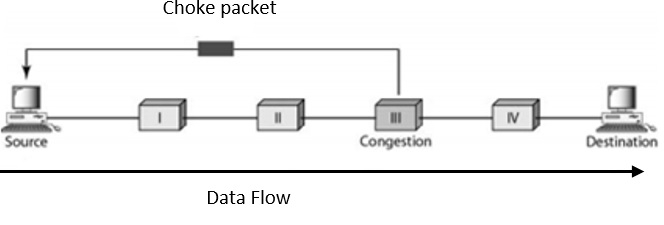
 Data Structure
Data Structure Networking
Networking RDBMS
RDBMS Operating System
Operating System Java
Java MS Excel
MS Excel iOS
iOS HTML
HTML CSS
CSS Android
Android Python
Python C Programming
C Programming C++
C++ C#
C# MongoDB
MongoDB MySQL
MySQL Javascript
Javascript PHP
PHP
- Selected Reading
- UPSC IAS Exams Notes
- Developer's Best Practices
- Questions and Answers
- Effective Resume Writing
- HR Interview Questions
- Computer Glossary
- Who is Who
What is closed Loop Congestion Control?
The reduction in the quality of service that occurs when a network node or a link carries more data than it can handle is called “Network Congestion”. The congestion in the network can lead to effects like packet loss or even blocking of new connections.
Therefore, Congestion in networks can be defined as, “A state that occurs in network layers because of the heavy message traffic that results in slowing down the network response time is called congestion”.
Effects of Congestion
Following are the effects of Congestion −
Because of the increase in the response time, the overall performance is reduced.
Also, in worst situations, because of the delay that takes place, re-transmission can also occur which worsens the scenario.
Classification of Congestion
The broader ways to classify the congestions are as follows −
- Practical network congestion
- TCP/IP congestion
Congestion Control techniques
To control the congestion in networks, the control techniques are broadly classified under two categories, which are as follows −
- The Open loop refers to the protocols that should be used in order to prevent congestion. That is, the congestion should not occur in the first place. This is based on the technique of having a good design implementation in order to prevent the congestion from taking place.
- The Close loop allows the system to enter in the congestion state if it occurs, detects it and then proceeds to remove the congestion. This is based on the feedback mechanism that is received. With the help of the feedback, one can detect and remove the congestion from the network.

Now let us discuss about closed loop congestion control in detail −
Closed Loop Congestion Control
The basic mechanisms of closed loop congestion control are as follows −
Backpressure
When a router is congested, it informs the previous upstream router to reduce the rate of outgoing packets.
If a node becomes congested it can slow down or halt flow of packets from other nodes and halt flow of packets from other nodes.
It means that other nodes have to apply control on incoming packet rates control on incoming packet rates.
Propagates back to source and it is not used in ATM or frame relay.
It is diagrammatically represented as follows −

Choke packet of choke point
It is sent by router to source, similar to ICMP’s source quench packet.
It is diagrammatically represented as follows −

Implicit signaling
It looks for delay in some other action.
Transmission delay may increase with Transmission delay may increase with congestion.
Packets may be discarded and the source can detect these as implicit indications of congestion.
Useful on connectionless (datagram) networks and it is used in frame relay LAPF.
Explicit signaling
The router sends an explicit signal. The network alerts end systems of increasing congestion and is used on connection-oriented networks. The end systems take steps to reduce offered load.
Backwards − Congestion avoidance info sent in opposite direction of packet travel.
Forwards − Congestion avoidance info sent in the same direction as packet travel.

